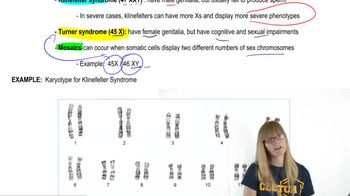Here are the essential concepts you must grasp in order to answer the question correctly.
Sex Determination Mechanisms
Sex determination refers to the biological system that determines the development of sexual characteristics in an organism. In Drosophila (fruit flies), sex is determined by the ratio of X chromosomes to autosomes, while in humans, it is determined by the presence of specific sex chromosomes (XX for females and XY for males).
Recommended video:
X:A Ratio in Drosophila
In Drosophila, the X:A ratio is crucial for sex determination. This ratio compares the number of X chromosomes to the number of sets of autosomes. A ratio of 1 (two X chromosomes to two sets of autosomes) results in a female, while a ratio of 0.5 (one X chromosome to two sets of autosomes) results in a male, showcasing a unique genetic mechanism distinct from that of humans.
Recommended video:
Chromosomal Sex Determination in Humans
Humans utilize a chromosomal sex determination system where the presence of the Y chromosome typically determines male sex. The SRY gene located on the Y chromosome initiates male development, while the absence of a Y chromosome leads to female development. This binary system contrasts with the more ratio-based system seen in Drosophila.
Recommended video:
 Verified step by step guidance
Verified step by step guidance Verified video answer for a similar problem:
Verified video answer for a similar problem:

